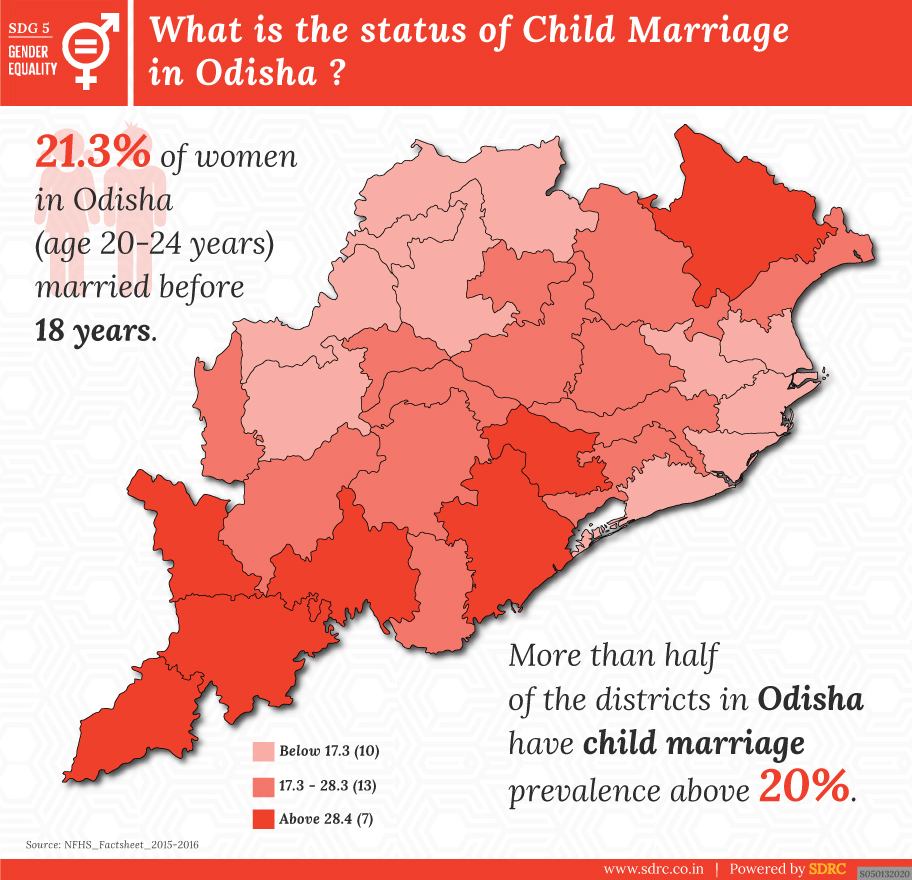The formal or informal wedding of female children below the age of 18 is illegal and a violation of human rights.
Marrying a girl child, before she attains physical and mental maturity, compromises her development and constraints her opportunities in life. Besides, pregnancy and delivery at an early age can result in infant and/or maternal mortality.
It, however, is prevalent in our country and in our state. As per the factsheet of National Family Health Survey (NFHS-4) 2015-16, in Odisha 21.3% women in the age group of 20-24 years were married off before the legal age (18 years).
More than half of the districts in the eastern Indian state have a child marriage prevalence rate of more than 20%.
At 39.3%, Malkanigiri reported the highest child marriage incidents followed by Nabarangpur (37.9%) and Koraput (34.7%). Other four districts reporting more than 28.4% of child marriages are Rayagada, Ganjam, Nayagarh, and Mayurbhanj.
Baleswar, Kendujhar, Debagarh, Anugul, Dhenkanal, Cuttack, Khorda, Subarnapur, Boudh, Kandhamal, Gajapati, Balangir, and Kalahandi are 13 districts with 17.3-28.3% child marriages reported.
Puri, Jagatsinghpur, Kendrapara, Bhadrak, Jajpur, Sundergarh, Jharsuguda, Baragarh, Sambalpur, and Sonepur are 10 districts with below 17.3% child marriage reports.
Why child marriages exist?
- Economically weaker people marry their girl child to avoid her responsibility.
- They tend to marry their male child to bring an additional hand to help in chores.
- They have no or little formal education and awareness about the risks of child marriage.
- They blindly follow age-old practices and superstitions.
- They intend to ensure optimum fertility and childbirth capacity of their children.
- They are concerned about the availability of suitable marriage partners for their children.
- They tend to believe that girls are inferior to boys.
What can be done to prevent child marriages?
- Educating girls: Keeping girls in school until they have completed basic level of education can play the most important role in preventing child marriages. This will ensure that girl children have the necessary knowledge and skills to find employment and support themselves and their families.
- Providing income opportunities to parents: Providing poor parents with employment opportunities can result in minimizing, even preventing, child marriages.
- Awareness of evils of child marriage: People should be made aware of evils of child marriage and the risks associated with it.
- Encouraging community leaders to support girls’ rights: Community leaders are responsible for deciding the girls’ future. Encouraging and incentivizing them to support the rights of girl children can prove to be beneficial.
To prevent a single case of child marriage in Odisha by 2030, the state government launched a Strategic Action Plan (SAP) with the support of United Nations Population Fund and UNICEF.
The image can be downloaded here.




